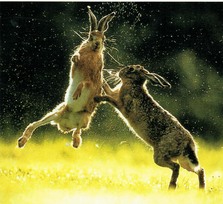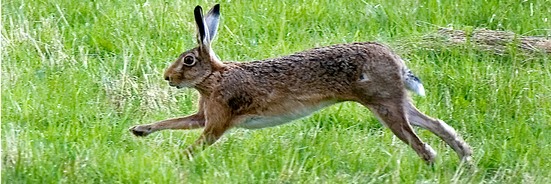

Biodiversity
Action
Plan
Brown and Mountain Hare: Conservation
Brown Hares feed on grasses and agricultural crops and favour open grassland with shelter nearby from hedgerows, woodland edges and longer grass in field margins. They also benefit from arable crops.
Mountain Hares favour heather moorlands, particularly those with some young heather and grasses for feeding and areas for cover.
Hares have a preference for areas of short vegetation in which to feed at night and taller vegetation in which to lie up during the day. Leverets spend their early days in forms in taller vegetation, so that they are well hidden from predators.
Factors causing Loss or Decline
- Loss of habitat diversity due to agricultural intensification
- Changes in cropping regimes, grassland management for silage, not hay; autumn sowing of cereals
- Overgrazing
- Excessive predation
- Hunting and control measures
- Mountain Hares in the Peak District are vulnerable also because they are isolated from other populations.
Legal protection.
As ‘game animals’, with certain restrictions, hares are allowed to be shot by farmers, landowners and their clients. They are protected during ‘close seasons’.
As Species of Principal Importance for the conservation of biodiversity, Brown Hare and Mountain Hare need to be taken into consideration by any public body in managing their estate. (Section 41 NERC Act (2006))
Mountain Hares are listed in Annex V of the EC Habitats Directive (1992), as a species 'of community interest whose taking in the wild and exploitation may be subject to management measures'. This is usually interpreted as the need to avoid local disappearance or serious disturbance.
Links to follow
Mammal Society: Brown Hare Sightings
PTES: Brown Hare
Mammal Society: Mountain Hare Sightings
PTES: Mountain Hare Peak District issues
Associated Local Priority Habitats
- Acid Grassland and Neutral Grassland
- Floodplain Grazing Marsh
- Open Mosaic on Previously Developed Land
- Hedgerow banks and Field Margins
Good practice in conservation management
For Brown Hare
- Create and/or maintain open grassland with some cover
- Maintain hedgerows and field margins
- Avoid over-grazing and keep some areas free of grazing in winter
- Protection from excessive predation and disturbance
For Mountain Hare
- Maintain varied areas of heather and grasses for feeding and cover
- Avoid over-grazing
- Protection from excessive predation and disturbance


Brown and Mountain Hare Conservation